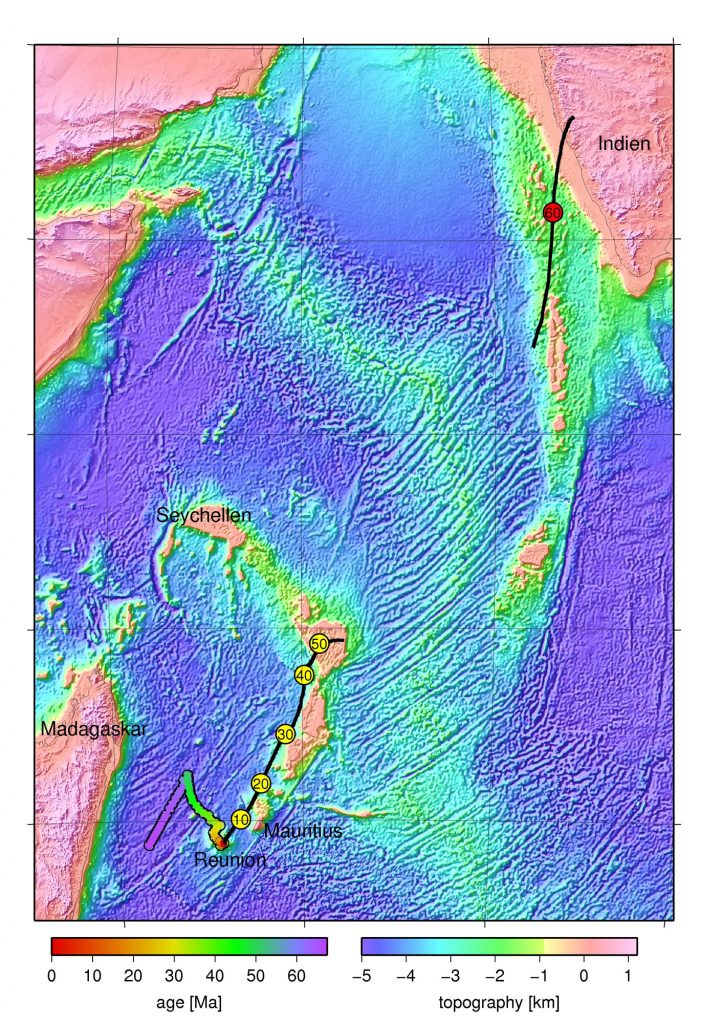
The colored track (left color scale) west of Reunion is the calculated movement of the Reunion hotspot. The black lines with yellow circles and the red circle indicate the corresponding calculated track on the African plate and the Indian plate, respectively. The numbers in the circles are ages in millions of years. The areas with topography just below the sea surface are now regarded as continental fragments. Credit: GFZ/Steinberger
Based on the study of lava sand grains from the beach of Mauritius, a newly published study from a group of geoscientists suggests that a micro-continent is hidden under lava in the Indian Ocean.
The islands Reunion and Mauritius, both well-known tourist destinations, are hiding a microcontinent, which has now been discovered. The continent fragment known as Mauritia detached about 60 million years ago while Madagascar and India drifted apart, and had been hidden under huge masses of lava. Such micro-continents in the oceans seem to occur more frequently than previously thought, says a study in the latest issue of Nature Geosciences (“A Precambrian microcontinent in the Indian Ocean”).
The break-up of continents is often associated with mantle plumes: These giant bubbles of hot rock rise from the deep mantle and soften the tectonic plates from below, until the plates break apart at the hotspots. This is how Eastern Gondwana broke apart about 170 million years ago. At first, one part was separated, which in turn fragmented into Madagascar, India, Australia, and Antarctica, which then migrated to their present position.
Plumes currently situated underneath the islands Marion and Reunion appear to have played a role in the emergence of the Indian Ocean. If the zone of the rupture lies at the edge of a land mass (in this case Madagascar / India), fragments of this land mass may be separated off. The Seychelles are a well-known example of such a continental fragment.
A group of geoscientists from Norway, South Africa, Britain and Germany have now published a study that suggests, based on the study of lava sand grains from the beach of Mauritius, the existence of further fragments. The sand grains contain semi-precious zircons aged between 660 and 1970 million years, which is explained by the fact that the zircons were carried by the lava as it pushed through subjacent continental crust of this age.
This dating method was supplemented by a recalculation of plate tectonics, which explains exactly how and where the fragments ended up in the Indian Ocean. Dr. Bernhard Steinberger of the GFZ German Research Center for Geosciences and Dr. Pavel Doubrovine of Oslo University calculated the hotspot trail: “On the one hand, it shows the position of the plates relative to the two hotspots at the time of the rupture, which points towards a causal relation,” says Steinberger. “On the other hand, we were able to show that the continent fragments continued to wander almost exactly over the Reunion plume, which explains how they were covered by volcanic rock.” So what was previously interpreted only as the trail of the Reunion hotspot, are continental fragments that were previously not recognized as such because they were covered by the volcanic rocks of the Reunion plume. It, therefore, appears that such micro-continents in the ocean occur more frequently than previously thought.
Reference: “A Precambrian microcontinent in the Indian Ocean” by Trond H. Torsvik, Hans Amundsen, Ebbe H. Hartz, Fernando Corfu, Nick Kusznir, Carmen Gaina, Pavel V. Doubrovine, Bernhard Steinberger, Lewis D. Ashwal and Bjørn Jamtveit, 24 February 2013, Nature Geoscience.
DOI: 10.1038/NGEO1736

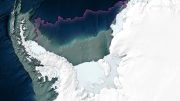

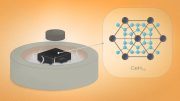

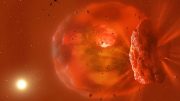

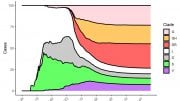
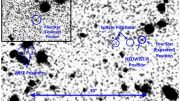
Be the first to comment on "Precambrian Micro-Continent Hidden in the Indian Ocean"